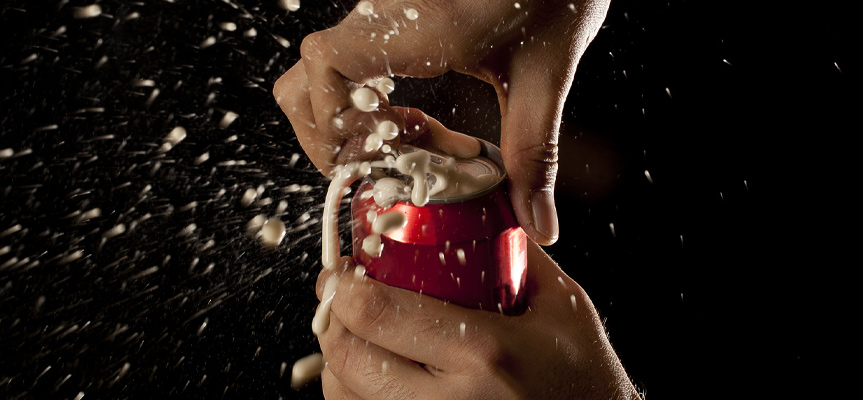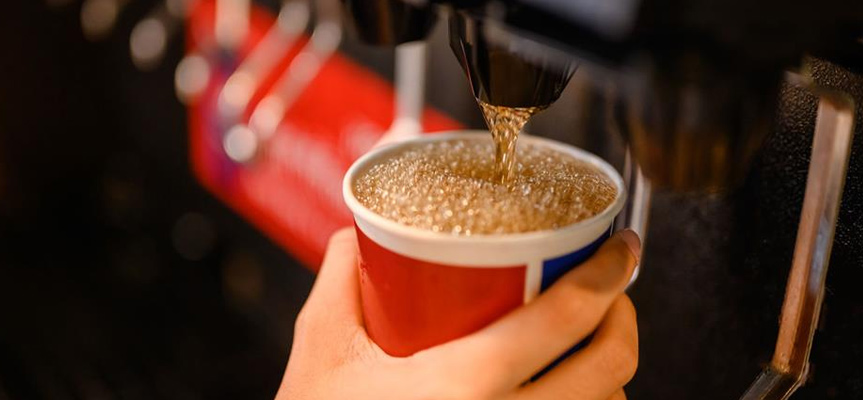The reason for the release of soda gas , may seem like a simple issue at first glance, but it holds within it a world of science, industry, and even consumer experience. Carbonated beverages, including soda, have a special place in our daily lives. The refreshing sensation and pleasant taste of carbon dioxide in soda is a familiar experience for many of us. But have you ever wondered why the gas escapes so quickly after opening the bottle?
This phenomenon is not just a basic physical reaction; it is a topic of importance for consumers, manufacturers, startups in the beverage industry, and even researchers in the field of food science. In this article, we will take a scientific yet accessible look at the exact reason behind the release of soda gas, the role of carbon dioxide (CO₂) in carbonated drinks, and methods for maintaining carbonation in soda bottles. Our goal is to provide valuable information that is both understandable for the general public and insightful for professionals in this field.
CO2 Gas in Soda: The Beating Heart of Carbonated Drinks
Carbon dioxide, or CO2, is the main substance that creates the fizzy characteristic in sodas. This colorless and odorless gas is added under pressure to the liquid soda, producing bubbles that bring freshness and liveliness to the drink. But why CO₂? Due to its unique chemical properties, such as high solubility in water and being harmless in standard amounts, CO₂ is an ideal choice for carbonating beverages. However, this solubility characteristic also makes CO2 easily escape from the soda, especially when the bottle is opened and external pressure changes.
Why does soda gas out so quickly?
One common question from consumers is why soda loses its carbonation. The answer lies in several factors:
- Change in ambient pressure: When the bottle cap is opened, the internal pressure that kept CO2 dissolved in the liquid quickly drops. This causes the gas to separate from the liquid and rise to the surface in bubbles.
- Temperature changes: Ambient temperature plays a significant role in carbonation loss. Higher temperatures reduce CO2 solubility in the liquid, so soda stored in warm conditions loses its gas faster.
- Shaking the bottle: Shaking before opening increases internal pressure and triggers faster gas escape. This is especially common in homemade sodas, where production control is less precise.

The Role of Temperature in Carbonation Loss
Temperature is a key factor in stabilizing carbonation in fizzy drinks. According to Henry’s law, the solubility of gases in liquids decreases as temperature increases. That is why soda stored at room temperature or above loses CO2 rapidly into the atmosphere. For instance, soda kept in a refrigerator retains its carbonation much longer. This is crucial information for both soda manufacturers and household consumers.
The Impact of Packaging on Soda Carbonation Stability
Packaging type plays a vital role in preserving soda carbonation. Plastic bottles, metal cans, and glass bottles each have their own characteristics:
- Plastic bottles: Lightweight and inexpensive, but due to their relative permeability to gases, they may lose more carbonation over time.
- Metal cans: Their sturdy structure prevents gas escape effectively, but opening the can causes a rapid drop in pressure.
- Glass bottles: With lower permeability, glass bottles are a better choice for long-term carbonation retention, though they come with higher production costs.
Additives in Carbonated Sodas and Their Role
Additives in carbonated sodas, including carbonation stabilizers like WINNOVENT, help maintain quality and gas retention. These additives include food acids (such as citric acid), sweeteners, and chemical stabilizers that regulate pH and increase gas solubility. For example, citric acid lowers the pH of the soda, creating a favorable environment for CO2 dissolution.
Some companies, like the Innovation and Creativity Center of Grownida, are developing natural carbonation stabilizers that not only keep the gas longer but are also more environmentally friendly. Such innovations assist manufacturers in producing higher quality products with longer shelf life.
Methods to Preserve Soda Carbonation
To prevent carbonation loss in soda, the following methods can be used:
- Storing at low temperatures: As mentioned earlier, refrigeration between 4 to 8 degrees Celsius is ideal.
- Sealing the bottle quickly: Leaving the bottle open causes rapid gas escape. Quickly resealing after each use maintains internal pressure.
- Using carbonation stabilizers like WINNOVENT: Innovative products such as Grownida’s carbonation stabilizer help maintain gas in sodas.
- Avoid shaking the bottle: shaking accelerates gas release.
- Resad more: What is a soda CO2 stabilizer and how does it work?

Why Do Homemade Sodas Have Less Carbonation?
Homemade sodas often contain less carbonation than industrial products due to the lack of advanced equipment and precise formulations. Factors contributing to carbonation loss in homemade sodas include:
- Lack of gas pressure control: Homemade production often lacks the equipment to inject CO2 under high pressure.
- Unstable formulation: Absence of suitable additives or improper pH adjustment reduces gas retention.
- Inappropriate packaging: Using non-standard bottles that cannot withstand gas pressure leads to carbonation loss.
Using stable formulations and natural CO2 stabilizers can effectively address these issues.
The Role of CO2 in Soda Flavor and Quality
CO2 not only provides the fizzy sensation but also influences the flavor and mouthfeel of soda. CO2 bubbles create a refreshing and cooling sensation attractive to consumers. Additionally, CO2 creates an acidic environment that inhibits microbial growth, increasing product shelf life.
The Impact of the Production Process on Soda Carbonation
The manufacturing process for carbonated soda involves several key steps:
- Dissolving CO2: Gas is injected into the liquid under high pressure.
- pH adjustment: Adding food acids to improve gas solubility.
- Packaging under pressure: Bottles or cans are filled in a pressurized environment to retain gas.
Any flaw in these steps can cause carbonation loss. For example, insufficient gas injection pressure results in soda with less carbonation from the start.
Learn more: The Difference Between Enhancers and Stabilizers
Carbonation Stabilizers: Innovations in the Beverage Industry
Carbonation stabilizers, such as those provided by innovative products from Grownida, are compounds that help retain gas in soda. These stabilizers regulate the chemical properties of the liquid, such as pH and viscosity, to increase gas solubility. Some stabilizers are made from natural ingredients like plant extracts, appealing especially to health-conscious consumers.
The Effect of Transportation Conditions on Soda Carbonation
Improper transportation can lead to carbonation loss. Exposure to high temperatures or vigorous shaking during transport can reduce gas content. Therefore, manufacturers must carefully manage their supply chain to preserve product quality.
How to Preserve Soda Carbonation at Home
For household consumers, simple methods to keep soda fizzy include:
- Refrigeration: Low temperatures are the best way to maintain carbonation.
- Using tight seals: Special caps that maintain pressure can be effective.
- Quick consumption: Drinking soda shortly after opening preserves carbonation.

The Role of Innovative Brands in Improving Soda Quality
Brands like Grownida, by offering innovative products such as their carbonation stabilizer, help manufacturers produce sodas with more stable carbonation. These products not only enhance drink quality but also reduce waste and increase customer satisfaction.
Challenges of Producing Sustainable Carbonated Soft Drinks
Producing carbonated soft drinks with sustainable gas presents its own specific challenges:
- Production Costs: Using WINNOVENT stabilizers and high-quality packaging is costly.
- Environmental Impact: The production of CO2 gas and packaging materials can have environmental effects.
- Market Demand: Consumers are looking for products with better taste and longer shelf life.
To overcome these challenges, innovative companies like the Grownida Innovation and Creativity Center are developing solutions that are both cost-effective and environmentally friendly.
Conclusion: The Future of Carbonated Beverages
The release of gas from soft drinks depends on multiple factors, including temperature, pressure, packaging, and formulation. By understanding these factors and applying appropriate methods such as storing at low temperatures, using gas stabilizers, and employing quality packaging, it is possible to preserve the carbonation in the beverage for a longer period. Brands like Grownida, by offering innovative products, have paved the way for producing higher-quality carbonated soft drinks. If you are looking for more information on methods to improve the quality of carbonated beverages, you can contact experts in this field or consult reputable resources.
Frequently Asked Questions
Why does the gas in soft drinks escape quickly after opening the bottle?
Gas escapes due to the reduction of internal bottle pressure and the separation of CO2 gas from the liquid. High temperature and shaking the bottle also accelerate this process.
How can the gas in soft drinks be preserved for a longer time?
Refrigeration, rapid capping of the bottle, and use of gas stabilizers such as Winnovent Grownida CO2 stabilizer can be effective.
Are CO2 stabilizers harmful to health?
Reputable CO2 stabilizers, like natural CO2 stabilizers, are generally safe and produced under health standards.
Why do homemade soft drinks have less carbonation?
Lack of advanced equipment, unstable formulation, and improper packaging are the main reasons for reduced carbonation in homemade soft drinks.
What is the role of CO2 in soft drinks?
CO2 creates bubbles and a sensation of freshness in the drink and, by adjusting pH, increases the product’s shelf life.

